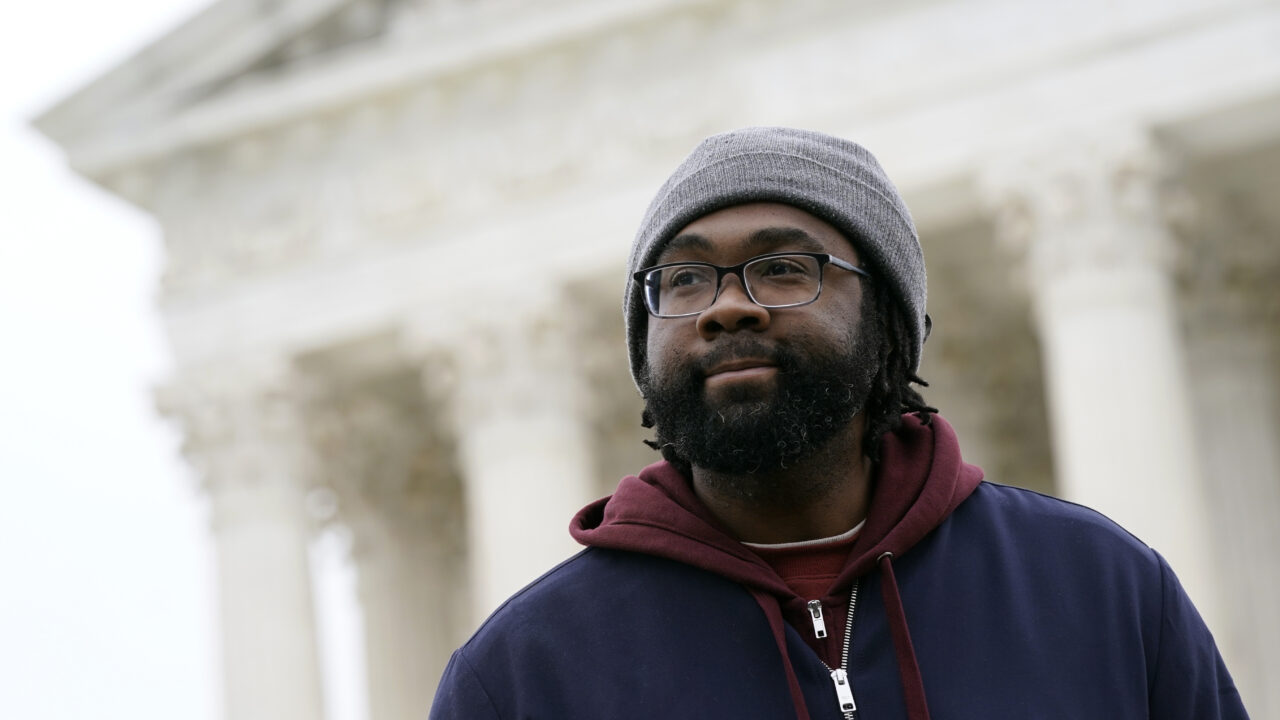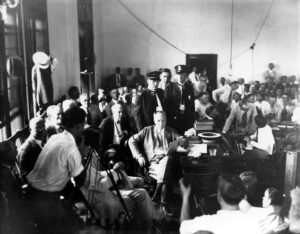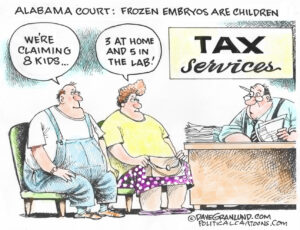The Supreme Court’s Ruling on Voting Rights Is Not as Good as It Seems
The decision to block a racist electoral map in Alabama comes with a fine-print caveat. FILE - Evan Milligan, plaintiff in Merrill v. Milligan, an Alabama redistricting case, listens to a reporter's question following oral arguments outside the Supreme Court on Capitol Hill in Washington, Oct. 4, 2022. The Supreme Court on Thursday, June 8, 2023, issued a surprising ruling in favor of Black voters in a congressional redistricting case, ordering the creation of a second district with a large Black population. (AP Photo/Patrick Semansky, File)
This is Part of the "The Supreme Court’s War on the Future" Dig series
FILE - Evan Milligan, plaintiff in Merrill v. Milligan, an Alabama redistricting case, listens to a reporter's question following oral arguments outside the Supreme Court on Capitol Hill in Washington, Oct. 4, 2022. The Supreme Court on Thursday, June 8, 2023, issued a surprising ruling in favor of Black voters in a congressional redistricting case, ordering the creation of a second district with a large Black population. (AP Photo/Patrick Semansky, File)
This is Part of the "The Supreme Court’s War on the Future" Dig series
It’s always important to read the fine print. This sage adage applies not only to credit card applications, auto loans, and mortgages, but also to the decisions of the United States Supreme Court.
At first glance, the Court’s ruling in Allen v. Milligan, released on June 8, appears to be a far-reaching victory for voting rights. In a 5-to-4 majority opinion written by Chief Justice John Roberts, the Court struck down Alabama’s racist new Congressional map for violating Section 2 of the Voting Rights Act (VRA) of 1965.
Numerous commentators have praised the decision. Upon close inspection, however, the ruling is narrow in scope, preserving a vital part of our most basic national voting law only by the slimmest of margins. Worse, the decision may turn out to be short-lived.
The blocked Alabama map was drawn up by the state’s legislature in November 2021 based on data derived from the 2020 U.S. Census. Although Black residents comprise roughly 27 percent of the total population, the map created only one Congressional voting district out of seven in which they would hold a majority.
Advocacy groups represented by the NAACP Legal Defense Fund and the ACLU sued to block the map, arguing that it contravened Section 2 of the VRA, which bans any “standard, practice, or procedure” that “results in a denial or abridgement of the right of any citizen . . . to vote on account of race or color.”
Upon close inspection, however, the ruling is narrow in scope, preserving a vital part of our most basic national voting law only by the slimmest of margins.
The groups also contended the new map ran afoul of the Supreme Court’s past precedent decisions that date back to the 1980s and outlaw “racial gerrymanders.” Such gerrymanders occur when a state uses race as the primary factor in redistricting to dilute the voting power of minority populations by either “packing” them into super-majority districts or “cracking” them into several white-majority districts. The Alabama map is a classic instance of packing.
Joined by the Court’s three Democratic appointees and Justice Brett Kavanaugh, Roberts issued a statutory decision in Milligan, agreeing that the Alabama map violated the Court’s past decisions on Section 2. But he did not write approvingly of those decisions.
More importantly—and here is where the fine print comes in—Roberts added a gratuitous observation at the end of his opinion that all but invites future Constitutional challenges to Section 2, writing: “The Court’s opinion today does not diminish or disregard the concern that [Section] 2 may impermissibly elevate race in the allocation of political power within the States. Instead, the Court simply holds that a faithful application of precedent and a fair reading of the record do not bear those concerns out here.”
In his concurring opinion, Kavanaugh also issued a warning to voting rights advocates, asserting that the protections against racial gerrymandering under Section 2 “cannot extend indefinitely into the future.”
* * *
The crimped nature of the Milligan decision is consistent with Roberts’ track record. It is not a departure.
In truth, John Roberts has never been a friend of voting rights. As a young lawyer working in the Reagan Administration, he authored several memos criticizing the VRA.
In 2013, as head of the nation’s most powerful judicial body, he composed the majority opinion in Shelby County v. Alabama (2013), which gutted provisions of the VRA that required state and local jurisdictions, mostly in the South, with histories of egregious voter discrimination to obtain advance federal approval—known as “preclearance”—before making changes to their election procedures. Roberts declared in Shelby that racial discrimination in voting practices was essentially over, writing that “things have changed dramatically” since the 1965 passage of the VRA.
In truth, John Roberts has never been a friend of voting rights.
In 2019, he continued his anti-voting-rights crusade, writing the majority opinion Rucho v. Common Cause, which removed the issue of political gerrymandering (the practice of designing voting maps to benefit the party in power) from the jurisdiction of federal courts. And in 2021, he joined a 5-to-4 majority ruling penned by Justice Samuel Alito that upheld Arizona laws prohibiting out-of-precinct voting, and criminalizing the collection of mail-in ballots by third parties.
Still, any liberal victory in today’s Supreme Court is noteworthy, and for that, we can breathe a sigh of relief. As a result of Milligan, the Alabama legislature will have to redraw the state’s voting map to include either an additional majority African American district or create new districts in which African American voters are more evenly distributed. The ruling could also bolster racial gerrymandering litigation underway in other states, although each contested voting map will have to be adjudicated on its own merits.
But don’t get carried away thinking that Roberts has changed his political stripes, or that his widely touted commitment to institutionalism means that he is prepared to stand up long-term to the Court’s hardcore rightwing bloc led by Justice Clarence Thomas. Roberts is also an ultra-conservative. He just favors a slower, more gradual approach to the erosion of fundamental rights. Death by a thousand cuts, if you will, rather than a bullet to the back of the head.
Your support matters…Independent journalism is under threat and overshadowed by heavily funded mainstream media.
You can help level the playing field. Become a member.
Your tax-deductible contribution keeps us digging beneath the headlines to give you thought-provoking, investigative reporting and analysis that unearths what's really happening- without compromise.
Give today to support our courageous, independent journalists.






Thank you for sharing!
_______________
http://essaypapers.reviews/